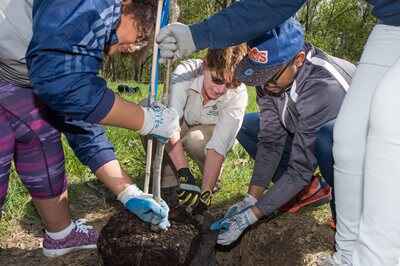From recreation and storm water management to fish and wildlife habitat, our region’s healthy, functioning ecosystems provide services for a healthy, functioning human society.
To that end, the Natural Resources Division, and for that matter, all Park District staff are committed to conserving and enhancing the fish, wildlife, plant, and geologic resources of Cleveland Metroparks through the application of sound ecological principles.
Management Philosophy
Our management philosophy is based on an ecosystem approach to natural resource management. An “ecosystem” is an interconnected community of living things, including humans, and the physical environment in which they all interact.
The ecosystem approach is a strategy for managing the land, water and living resources that promotes conservation and sustainable use in an equitable way based on appropriate scientific methods that consider the interactions among organisms and their environment.
Humans, with their cultural diversity, are an integral component of many ecosystems.
Management Techniques
Some management techniques such as prescribed fire or brush-hog mowing are used to mimic natural disturbances that create and sustain particular habitats. For example, fire is an important tool for maintaining prairie ecosystems, which are preferred by blue-winged warblers, indigo buntings, and numerous butterflies found in our remnant prairies.
Other management tools are used to enhance, restore, or recreate wetlands and streams that are important breeding and foraging habitat to amphibians, reptiles, birds, and insects. Tools may include placing water control structures, stabilizing stream banks, and planting native trees, shrubs, forbs, and grasses.
Responding to Problems

Natural resource management often involves taking action in response to stress factors affecting ecosystem health. Just like the built infrastructure of buildings, roads, and picnic areas need constant care and maintenance because of prolonged use, our natural infrastructure also needs maintenance.
Invasive plants and animals, storm water, deer, and people all place enormous amounts of pressure on the natural ecosystems found in Cleveland Metroparks. For example, emerald ash borer threatens all ash trees, which may include up to 10% of our forest trees. Lesser celandine, Japanese knotweed, purple loosestrife, and garlic mustard are just of few of the exotic plants that are replacing our native wildflowers, grasses, and sedges.
High deer populations lead to excessive browsing, which reduces or eliminates native plants, jeopardizing future forest regeneration and affecting other wildlife such as forest nesting birds.
Increased storm water run-off moves silt and pollutants (including sewage) into our lakes, streams, and rivers not only affecting the fish and invertebrates living there, but also increasing the cost to produce drinking water.
And finally, people place stress on Cleveland Metroparks not only through normal use (by millions of visitors) but also through illegal actions such as removing wildflowers, dumping yard waste, and creating new trails.
